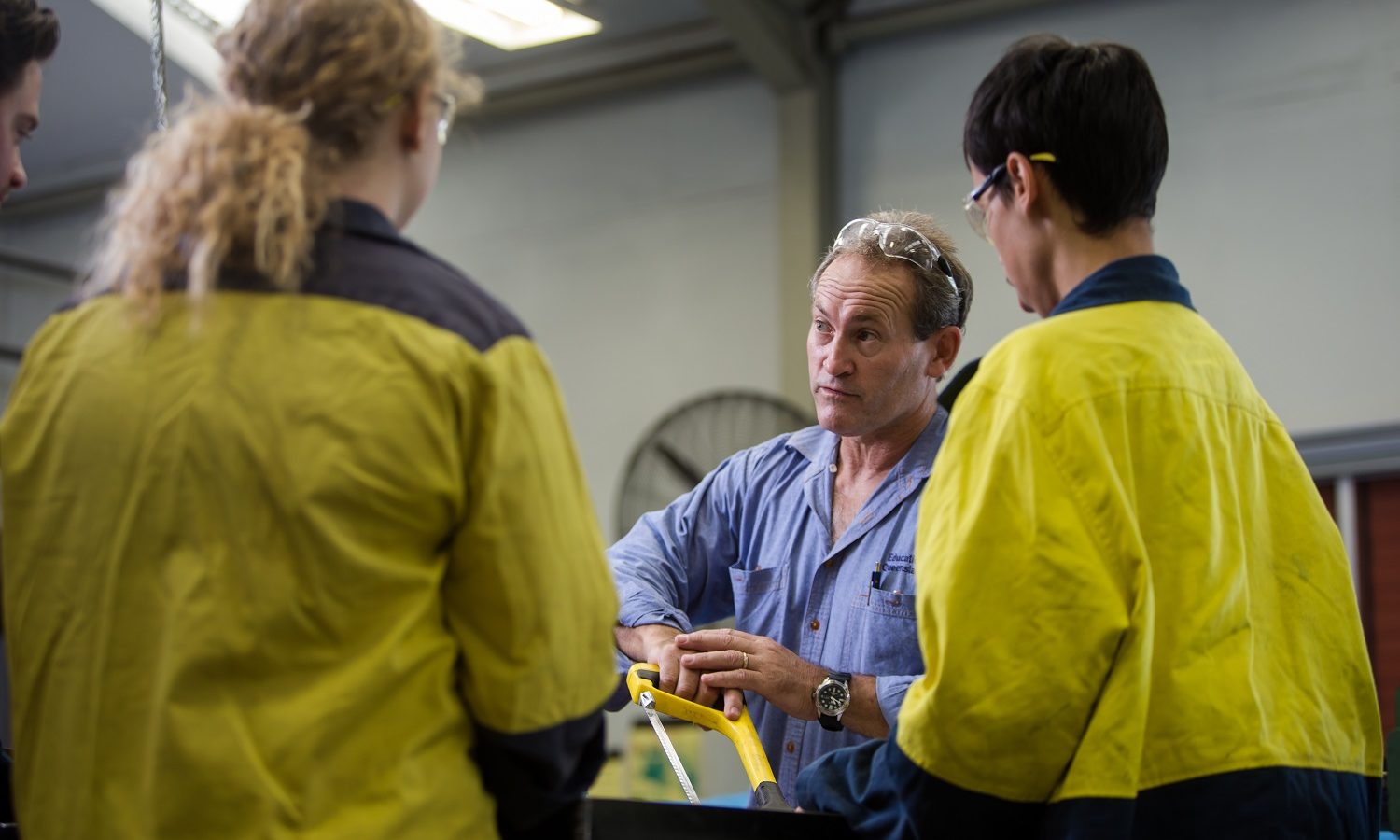Key Points
- Vocational education and training (VET) teaches practical workplace skills through training organisations.
- VET offers courses for hundreds of different occupations – not just trades.
- Almost 80 per cent of VET graduates are in work after completing their course.
- Students can do VET, including apprenticeships and traineeships, while still at school.
- VET can help young people get into university and gain credits for some degrees.
Students can learn workplace skills for hundreds of different occupations through studying vocational education and training (VET) courses while still at school. They can receive their training at school, from a public training organisation, or from a private training organisation. Some people still think VET is just for learning trades but it’s so much more than that. In this article, we debunk some of the myths about VET and find out why studying a VET course can set young people up for a successful future after they leave school.
![]() MYTH: VET is just for people who want to do a trade
MYTH: VET is just for people who want to do a trade
VET courses can help people gain professional nationally recognised qualifications in more careers than you’d expect – and not just in the trades. People who study VET courses can become aeronautical engineers, nurses, social workers, software designers, zookeepers, landscape gardeners, or fitness instructors, just to name a few. There are thousands of qualifications to choose from ranging from Certificate I to Certificate IV, and Diploma, Advanced Diploma, Vocational Graduate Diploma and Vocational Graduate Certificate. VET also offers many university preparation courses for those that are looking for alternative pathways into higher education. Read more about the many different jobs you can do with a VET qualification.
![]() MYTH: VET graduates struggle to get a job
MYTH: VET graduates struggle to get a job
Vocational education and training courses are designed to meet the current and future needs of the job market so having a VET qualification can actually make you more employable. Almost 80 per cent of VET graduates find a job after completing their course. That’s a higher employment rate than university undergraduates. And many people who study a VET course can earn while they learn. According to the ‘Perceptions are not reality’ report (2017):
- 78% of VET graduates are employed after training.
- 82% of graduates who participated in VET as a part of an apprenticeship or traineeship are employed after training.
- The graduate employment rate of VET students who train as part of a trade apprenticeship is as high as 92%.
A VET qualification is nationally recognised and valued by employers all over the country including some of Australia’s biggest companies. The future world of work needs people with a range of skills who can move from industry to industry to meet demand where it’s needed. VET helps people develop skills that can take them from job to job through training that focuses on the skills they will need in the workplace. In-demand jobs in care and community, hospitality, and the services industries (such as retail, real estate, administration, and telecommunications) are all covered by VET.
![]() MYTH: VET is for people who aren’t academic
MYTH: VET is for people who aren’t academic
VET is for anyone who wants to get the skills they need to get a job in hundreds of interesting and exciting careers in industries ranging from:
|
|
|
|
|
|
|
|
|
|
|
|
VET can also help young people get into university and even gain credits for some degrees. In Queensland, students who do four general subjects, plus one VET qualification at Certificate III or above are eligible to receive an ATAR to gain entry to university.
![]() MYTH: University graduates earn more than a VET graduate
MYTH: University graduates earn more than a VET graduate
The research findings differ depending on whether you are looking at starting salaries or money earned over the course of a person’s working life. Here are some of the research findings:
- The ‘Perceptions are not reality’ report (2017) found that, on average, VET graduates have the same, and sometimes higher, starting salaries as university graduates.
- However, in its ‘Is tertiary education worth it?’ report published in 2018, KPMG found that people with a university qualification were likely to earn more over the course of their working lives than someone with a VET qualification.
- The KPMG report also found that those who finish Year 12 earn more than those who do not.
Other interesting findings from the ‘Perceptions’ report include:
- In comparison with university undergraduate programs, VET usually provides students with a faster, more cost-effective pathway to complete a qualification and enter the workforce.
- The employment rate for VET graduates is 78% while the employment rate for graduates from a bachelor’s degree program is 69%.
- VET graduates have the capacity to earn higher salaries than many bachelor’s degree graduates.
- More people enrol in VET after university than before they go so they can build on their degree and get the workplace skills they need to get the job they want.
![]() MYTH: VET isn’t relevant anymore
MYTH: VET isn’t relevant anymore
VET has never been more relevant. According to the Foundation for Young Australians ‘New Work Order’ report series, today’s 15 year-olds are likely to navigate 17 changes in employer across five different careers. VET offers the kind of flexible training that will help young people navigate the future world of work.
- In 2019, 4 million people gained a VET qualification in Australia.
- Students can do apprenticeships and traineeships while still at school and earn while they learn.
- VET equips young people for ten of the top 10 jobs predicted to see the fastest growth in demand in coming years, such as sales, aged care, child care and hospitality.
- More people enrol in VET after university than before they go so they can get the workplace skills they need to get the job they want.
- A VET qualification is nationally recognised and valued by employers all over the country, including some of Australia’s biggest companies.
- VET continues to deliver great results in a range of areas and, because of its links with industry, is flexible, adaptable, practical and up-to-date.
- VET courses are flexible so people can do partial qualifications, short courses, and individual skill sets and units of competency, allowing them to gain the skills they need, when they need them.
- For young people who are not sure what they want to do when they finish school, studying a VET course allows them to keep their options open while gaining valuable skills for the workplace.
![]() MYTH: People who study VET cannot go to university
MYTH: People who study VET cannot go to university
VET can help young people get into university and even gain credits for some degrees. In Queensland, school students who do four general subjects, plus one VET qualification at Certificate III or above are eligible to receive an ATAR to gain entry to university. Plus, some training providers offer university preparation courses that can help young people gain entry to university if they were not eligible for an ATAR when they finished school.
Talk to your teen’s school
Schools can work with you and your teen to decide whether a VET pathway is right for your child. If your teen wants to keep their options open or is unsure about what they want to do when they finish school, doing a mix of school subjects and VET might be a good solution for them. In Year 10, the team at your child’s school will work with you and your teen on their Senior Education and Training Plan (or ‘SET plan’ for short). This process is the ideal time to explore the different options, including VET pathways, available to your teen during their senior years at school.

Find out more
Last Updated: 22 February 2024





